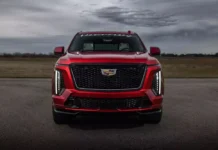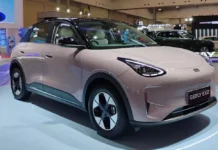
|
After a long wait, Mercedes-Benz’s factory in Go Vap District, Ho Chi Minh City, has finally been granted a five-year extension, starting from April 14, 2025.
This means that the German automaker’s domestic car assembly operations will continue until April 14, 2030. This is considered a “success” for Mercedes-Benz in its efforts to maintain its presence in Vietnam and uphold its leading position in the luxury car market.
Competitive pricing for locally assembled models has been a key factor in the brand’s rise to the top of the luxury car market in Vietnam, and this advantage is set to continue. However, Mercedes-Benz still has work to do if it wants to stop its market share from eroding further and prevent its luxury car market share from being overtaken by competitors.
Mercedes-Benz’s Stronghold
In 1996, Mercedes-Benz Vietnam introduced the E230 (W210) – the first luxury car to be assembled domestically at its factory in Go Vap District, Ho Chi Minh City.
Since then, the brand’s range of locally assembled models has expanded significantly, from the E-Class to the C-Class, including the Mercedes-Benz C 300 AMG and Mercedes-AMG C43, as well as SUV variants of the Mercedes-Benz GLC.
| |
|
The Mercedes-Benz E230 was the first luxury car assembled by Mercedes-Benz in Vietnam. |
Compared to imported competitors in the same segment, Mercedes-Benz’s locally assembled models offer a pricing advantage. This has been instrumental in helping Mercedes-Benz become the leading brand in the luxury car market, surpassing fellow German brands such as BMW, Audi, and Porsche.
Local assembly also means that these Mercedes models benefit from a 50% reduction in registration fees during the government’s support programs. With prices in the billions of VND, the cost savings from the reduced registration fee programs for Mercedes vehicles can amount to hundreds of millions of VND.
| |
|
The Mercedes-Benz GLC 200 4Matic is assembled in Vietnam. Photo: Mercedes. |
For example, Vietnamese customers who purchase the Mercedes-Benz E-Class currently benefit from a registration fee reduction of at least 94 million VND and up to 173 million VND, depending on the version and the locality where the car is registered.
The registration fee advantage for the GLC line ranges from 115-138 million VND for the GLC 200 4Matic to 140-168 million VND for the GLC 300 4Matic, depending on the locality of registration.
With strong fundamentals, a well-established brand, and quality products, Mercedes-Benz has dominated the luxury car segment in Vietnam for a long time, with its main competitors, such as Lexus, BMW, and Audi, lagging behind. However, this situation is changing rapidly.
Challenges for the German Automaker
For now, the five-year extension of the assembly plant’s operations will help Mercedes-Benz maintain its pricing advantage over its competitors in the luxury car market.
| |
|
Mercedes-Benz’s electric vehicles have not performed well in terms of sales in Vietnam. |
Electric vehicles and sports cars, which Mercedes-Benz has been promoting heavily for the past two years, have not been well-received by the market, partly due to economic difficulties and partly due to less-than-impressive products.
Mercedes-Benz’s electric vehicles are facing challenges not only in Vietnam but also globally. The incident of a Mercedes electric car catching fire in South Korea raised safety concerns and showed that the German brand may have rushed its electrification strategy.
The brand’s core models in terms of sales, including the GLC, C-Class, and E-Class, have not received comprehensive upgrades in a long time, or the upgrades have not been significant enough to maintain their competitiveness.
For example, the GLC, a small SUV that was first introduced in 2015, only received its second generation in 2022. The Mercedes-Benz C-Class entered its fifth generation in 2021, and the next generation is not expected until 2026.
The new models that Mercedes-Benz plans to launch this year are expected to generate excitement among customers. However, they are unlikely to be the brand’s main sales drivers, meaning they may not contribute significantly to increasing sales volume.
As a result, Mercedes-Benz’s strategy for this year will rely almost entirely on its existing product lines, along with a dedicated exhibition that the brand will hold in Hanoi in October.
Mercedes-Benz also frequently offers price reductions for models from previous years. While this can stimulate customer purchases, it is considered a risky move as it may create an expectation of price drops among buyers. This strategy can also negatively impact brand value, as existing customers may feel dissatisfied due to depreciation or because they see many others owning the same luxury car at a lower price.
The biggest challenge facing not only Mercedes-Benz but also the entire automotive market in Vietnam in 2024 is the economic downturn, which is affecting both the mass-market and luxury segments.
How to Maintain the Top Position?
Ironically, the challenging market conditions can also be seen as an opportunity for Mercedes-Benz, as competitors will find it difficult to make significant gains while the German brand is still navigating its way forward. Even with attractive products and competitive pricing, luxury cars will not sell as well in this phase as they did during the “golden days”. It is predicted that in about two years, when the economy recovers and people have more disposable income to spend on luxury cars, Mercedes-Benz will also be ready with significant upgrades to maintain its position.
Mercedes-Benz’s dealer network is still better than that of many other luxury car brands in Vietnam. Haxaco, one of its dealers, operates five dealerships in major cities, including Hanoi, Ho Chi Minh City, and Can Tho. While the difficult situation is inevitable, this network will be crucial in helping Mercedes-Benz maintain its sales volume during the market recovery phase.
| |
|
Mercedes-Benz still holds the largest market share, but its sales have been declining. |
The extension of the operation of the assembly plant in Go Vap District, Ho Chi Minh City, is good news for Mercedes-Benz Vietnam, as it allows the brand to maintain its leading position in the luxury car market by leveraging the pricing advantage of locally assembled models.
It appears that Mercedes-Benz Vietnam has made plans to overcome this challenging period. The brand has appointed a new leader, Mr. Gerd Bitterlich, who took over as CEO of Mercedes-Benz Vietnam on July 1, 2024. He is expected to restructure the German brand in Vietnam and select more suitable products for the market.
Only time will tell how Mercedes-Benz will navigate this difficult period and whether the brand will be overtaken by its German rival, BMW, in Vietnam.
Recommended Books for Your Car Journey
The “Xe” section introduces readers to interesting books with a variety of topics. During your travels in your car, there will be moments of rest and relaxation, and books can be a great companion during those times.












































